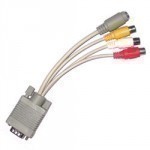Many computer owners find the multiple monitor features extremely useful. The multiple monitor feature has been around for many years and is available on Macintosh computers, Linux computers and Windows Operating systems- specifically on Windows 98, ME, XP, and Vista. It is quite easy to add one or more monitor to your computer, however there are generally only two modes available. They are Mirror Mode and the Multi Monitor Mode. Mirror Mode The first mode is called the mirror mode. In mirror mode, the second monitor you add will be Read More
How to Convert DVI-D to VGA

VGA (Video Graphics Array) is a hardware specification for display monitors and computers that allows a computer to display applications on a VGA-based monitor via a VGA cable. VGA technology is one of the oldest forms of display hardware in computing and is outfitted in virtually every computer system in the world. VGA uses analog signals but is compatible with most digital devices. While DVI technology has superseded VGA technology, both specifications are often included in personal computers, with VGA technology being much more common in laptop computers than desktop Read More
VGA (Video Graphics Array)
The term Video Graphics Array can be used to refer to many different things, but the original usage was by IBM for the graphics standard implemented in their PS/2 computer line. The original IBM VGA standard marketed in 1987 consisted of a 640 pixel by 480 pixel 16-color display at its highest resolution, but also included lower resolutions. Among those alternate modes, the 320 by 200 pixel 256-color "Mode 13h" was a common resolution for computer games because of the increased range of colors available to developers. Some of the Read More
DVI (Digital Visual Interface)
DVI (Digital Visual Interface) is a video connector designed by the Digital Display Working Group (DDWG), aimed at maximizing the picture quality of digital display devices such as digital projectors and LCD screens. It is crafted for transporting uncompressed digital video information to a display screen. It is partly compatible with the High-Definition Multimedia Interface (HDMI) standard in digital mode (DVI-D), and VGA in analog mode (DVI-A). DVI Vs. Older Video Technologies Previous standards such as Video Graphics Array (VGA) were designed exclusively for CRT-based devices and hence did not Read More
Digital Media Players
Digital media players are hardware devices that are designed to receive data from a source to be streamed and viewed/heard through a television or sound system. The hardware processes the signal in one of two ways: Wired Network – Some digital media players connect to the network through a wired connection. An Ethernet connection to a router is necessary to allow access to files on a PC or Network Storage location such as a server or hard disk that is set up through the digital media player. Wireless Network – Read More
SVGA (Super Video Graphics Array)
SVGA is an acronym for Super Video Graphics Array and covers a wide range of computer display standards used in the manufacture of computer monitors and screens. The SVGA standard was designed by VESA, the Video Electronics Standards Association. When using SVGA as a direct comparison to other display standards such as XGA (Extended Graphics Array) or VGA (Video Graphics Array) the standard resolution referred to as SVGA is 800*600 pixels. When the SVGA standard was first defined it referred to a resolution of 800*600 4-bit pixels (total number of Read More
How to Convert FLV to MPEG
Two common video files that are found on the Internet include FLV (Flash Video) and MPEG (Motion Pictures Expert Group). While both are extremely easy to view and store, many computer users still prefer to convert Flash files to MPEG (specifically MPEG-2) for viewing on either PC Based media player or home DVD players. While it is easy to convert one type of file to the other, it is important to be aware of each file's attributes. What is a Flash File (FLV)? Flash files are used primarily on the Read More
Screen Spanning
Screen spanning is a computer system obtaining dual monitors while working correctly. In other words, to have more than one monitor for a single computer. Instead of running several applications on one monitor, multiple monitors can be used for several, individual purposes ( i.e, having one monitor display communication devices while the other monitor display work related programs). Others once speculated that to save time from switching from task to task, a computer would need to be assigned specifically for each duty. However, with the technology of today, one can Read More
How to Connect a Computer to a TV

In the modern world of technology, almost any device can be tethered to another in order to increase performance and processing capabilities. An example of this is the ability to connect a computer to a television. This can be done in order to record television shows and movies or to control the television in question via software. A computer can be connected to a television via several means, each of which provides the user with a slightly different method of controlling the television or performing other tasks. S-Video Cable The Read More
How LED Lights Work

LEDs (Light Emitting Diodes) are now found on almost every electronic device including MP3 players, DVD players, TVs, clock radios, and computers. LEDs have been popular for decades. However, today they are cheaper, brighter and come in more colors than ever before. While the incandescent light bulb has been the light of choice for at least 100 years, many believe the LED will soon replace it. Here is how LED light bulbs work. What is an LED Light Bulb? LEDs are very similar to traditional light bulbs, except that they Read More


Share on: